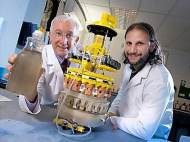EcoBot-III robot can be powered by sewage waste
 A couple of years ago I stumbled onto news about EcoBot – a robot able to operate within an enclosed environment by using food, water and air found around it. However, the idea of robots which consume unrefined biomass in order to operate didn’t allure me from the ethical point of view and that news never got covered. However, the latest version of the EcoBot-III is far more practical since it is able to operate on sewage waste and it could be beneficial for sewage maintenance.
A couple of years ago I stumbled onto news about EcoBot – a robot able to operate within an enclosed environment by using food, water and air found around it. However, the idea of robots which consume unrefined biomass in order to operate didn’t allure me from the ethical point of view and that news never got covered. However, the latest version of the EcoBot-III is far more practical since it is able to operate on sewage waste and it could be beneficial for sewage maintenance.
EcoBot-I was developed back in 2002, by a group of researchers at the Bristol Robotics Laboratory (BRL), UK, and it used sugar as the fuel and ferricyanide in the cathode, to move toward light (phototaxis). In 2004, the same research team created EcoBot-II which was able to perform sensing, information processing, communication and actuation phototaxis, by utilizing unrefined biomass. The first version consumed dead flies, rotten fruits and crustacean shells as the fuel and oxygen from free air as the cathode.
These two EcoBots do not require any other form of conventional power supply and do not require any form of initial charging from an external source to operate. The robots employ onboard microbial fuel cells (MFCs) – bio-electrochemical systems that drive a current by mimicking bacterial interactions found in nature – in order to generate the needed power.
The early stage work for the EcoBot-III project was finished in 2007 and it provided the foundation for the BREADbot development. The main objective of this project was to develop a robot with onboard fluid circulation, capable of collecting its energy from the environment and getting rid of its own waste while being powered only by MFCs.
The latest version of EcoBot-III feeds off and is powered by sewage from Saltford sewage treatment works, near Bristol, and can move and operate its onboard mechanisms unaided by power aside the one provided by MFCs which transform waste into electricity. It was developed through a partnership between scientists at Wessex Water and the BRL – a collaborative research partnership between UWE Bristol and the University of Bristol.
“One of the main drivers for this research was remote area access, where artificial agents can operate for prolonged periods by utilizing the organic matter in their vicinity”, said Dr Ioannis Ieropoulos, a senior research fellow at the BRL. “The successful collaboration with Wessex Water has not only helped us realize and implement such an adventurous project, but has also revealed the new and fertile area of energetically autonomous wastewater treatment in the research.”
The robot weighs 6kg (13.2 pounds) and has the appearance of a three-tiered wedding cake. The upper most component of the robot consists of the ingestion, artificial digestion and solid waste excretion mechanism. The middle section of the robot consists of the sludge distribution mechanism (white solid helical rings), and 24 MFCs. Underneath the MFCs there is an overflow collection tray which feeds back into the ingestion vessel above.
“Currently our treatment processes are energy intensive, but if there was a way of replicating the EcoBotIII on a larger scale, some processes could be powered on the sewage they are treating”, said Dr Julian Dennis, Wessex Water’s director of innovation and research, who initiated the idea of using waste from sewage works. “It would eliminate the need for electricity and would mean that in the future, sewage treatment works could become self-sufficient – driving down operational costs and significantly reducing our carbon footprint.”









Leave your response!